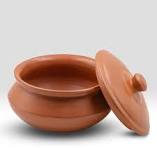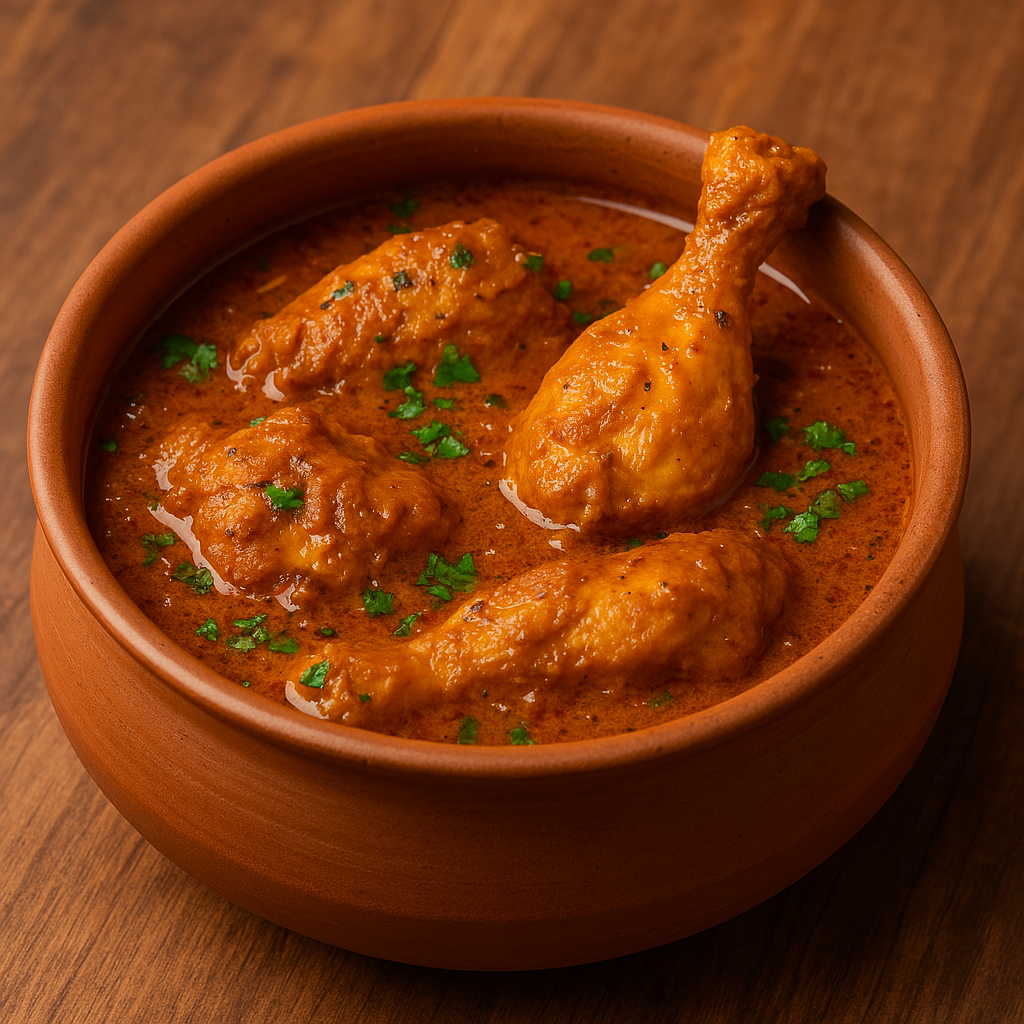Table of Contents
ToggleHandi Chicken
Handi Chicken is a rich and aromatic Indian dish that derives its name from the traditional cooking vessel in which it’s made — the “handi,” a wide-mouthed, deep, earthen or metal pot. This slow-cooked chicken curry, brimming with authentic spices, creamy yogurt, and tender meat, embodies the essence of traditional Indian cooking. Revered for its rustic charm and depth of flavor, Handi Chicken has carved out a prominent place in Indian households and restaurants alike.
Origins and Cultural Significance
The origins of Handi Chicken are deeply intertwined with the royal kitchens of North India and Pakistan. The handi itself has been a culinary staple for centuries, particularly in Mughlai and Awadhi cuisine. These ancient cooking traditions prized slow-cooking techniques that allowed spices and ingredients to mingle gradually, creating an intensely flavorful dish.
Handi Chicken is a prime example of these techniques. The dish was often prepared in clay pots placed over wood or charcoal fires, allowing the meat to cook gently while absorbing the smoky flavor of the fire and the earthy aroma of the handi. It was a favorite in feasts, weddings, and royal banquets — a symbol of warmth, hospitality, and indulgence.
Today, Handi Chicken is found not only in India but across South Asia and in Indian restaurants around the world. While modern kitchens often replace the clay handi with steel or nonstick cookware, the spirit of the dish — slow-cooked and spice-laden — remains untouched.

The Cooking Vessel: What is a Handi?
The handi is more than just a cooking utensil; it’s an essential component in the dish’s character. Traditionally made of clay, the handi has a round bottom, thick walls, and a narrow neck, which helps in retaining heat and moisture. This makes it ideal for preparing dishes that require long simmering or slow roasting. When used for cooking Handi Chicken, the vessel acts as a natural pressure cooker. The ingredients are allowed to cook in their own juices, resulting in a richer and more nuanced flavor profile. The thick walls ensure even cooking, preventing burning or uneven texture.
Key Ingredients and Preparation
Handi Chicken is a dish that’s both humble in preparation and grand in flavor. The recipe typically includes:
Chicken: Bone-in pieces are often preferred for deeper flavor. They absorb the spices well and remain juicy after long cooking.
Onions and Tomatoes: These form the base of the curry. Onions are usually slow-fried to a golden brown, lending sweetness and body, while tomatoes add acidity and color.
Yogurt: Adds creaminess and a tangy dimension. It also helps tenderize the chicken during the slow cooking process.
Ginger and Garlic Paste: Essential for the deep, earthy flavors that define Indian curries.
Whole and Ground Spices: Cumin, coriander, turmeric, garam masala, and red chili powder are used to create a layered and complex flavor profile.
Cream or Cashew Paste (optional): For a more indulgent version, some recipes include cream or a ground cashew-almond paste to add richness.
The preparation begins with marinating the chicken in yogurt, salt, turmeric, and chili powder. This not only flavors the meat but also ensures it stays juicy throughout the cooking process.
In a handi (or heavy-bottomed pot), whole spices like bay leaves, cardamom, and cinnamon are tempered in ghee or oil. Onions are then added and fried until deeply caramelized. This is followed by the ginger-garlic paste, and then the tomatoes, which are cooked down into a thick, spiced masala. Once the oil separates from the mixture — a sign that the masala is cooked — the marinated chicken is added.
The chicken is stirred to coat it in the masala, then left to cook on low heat with the lid tightly covered. Occasionally, a splash of water or stock is added if the curry thickens too much. After 30–40 minutes of slow cooking, the chicken becomes tender, and the gravy turns rich and concentrated.
Handi Chicken Recipe (Restaurant Style)
Ingredients
For Marination:
500g (1 lb) chicken (bone-in or boneless)
½ cup yogurt (thick, hung curd works best)
1 tbsp ginger-garlic paste
1 tsp red chili powder
½ tsp turmeric powder
Salt to taste
1 tsp lemon juice
For the Gravy:
2 tbsp ghee or oil (or mix of both)
2 onions (finely sliced)
2 tomatoes (pureed or finely chopped)
1 tbsp ginger-garlic paste
2 green chilies (slit)
½ tsp cumin seeds
1 tsp coriander powder
½ tsp garam masala
1 tsp red chili powder (adjust to taste)
½ tsp turmeric powder
½ tsp kasuri methi (dry fenugreek leaves)
¼ cup fresh cream or 2 tbsp cashew paste (optional, for richness)
Salt to taste
Fresh coriander leaves (for garnish)
Instructions
1. Marinate the Chicken
Mix chicken with yogurt, lemon juice, turmeric, chili powder, salt, and ginger-garlic paste.
Cover and refrigerate for at least 1 hour (overnight for best flavor).
2. Sauté the Base
Heat ghee/oil in a handi (or any thick-bottomed pan).
Add cumin seeds. Once they splutter, add sliced onions and sauté on medium heat until golden brown.
Add ginger-garlic paste and green chilies. Sauté until raw smell disappears.
3. Cook the Masala
Add tomatoes and cook until oil separates from the mixture.
Add coriander powder, turmeric, red chili powder, and salt. Mix well and cook for 2–3 minutes.
4. Add Chicken
Add the marinated chicken into the handi.
Mix and cook on medium heat for 7–8 minutes or until chicken starts to firm up.
Reduce heat to low, cover with a lid, and let it cook slowly for 20–25 minutes, stirring occasionally.
5. Finish the Gravy
Once the chicken is cooked and tender, add cream or cashew paste (optional).
Sprinkle crushed kasuri methi and garam masala.
Simmer uncovered for another 5 minutes until the gravy thickens.
6. Garnish & Serve
Garnish with fresh coriander leaves.
Serve hot with naan, roti, or steamed rice.
Regional Variations
Though the core idea of Handi Chicken remains the same — chicken cooked in a sealed pot with spices — different regions add their own touch to the dish:
Punjabi Handi Chicken: Richer and creamier, often with added butter or malai (fresh cream). It tends to be spicier and more robust.
Hyderabadi Handi Chicken: Often includes ground nuts (cashews or almonds) and is slightly tangier due to the inclusion of tamarind or extra yogurt.
Pakistani Style: Sometimes prepared with more oil and enhanced with green chilies and fresh coriander at the end for an extra punch.
Rajasthani Version: May include dried spices like dry mango powder (amchur) or fennel for a slightly different flavor dimension.
These regional tweaks not only reflect local taste preferences but also showcase the versatility of the handi-based cooking style.
Serving and Accompaniments
Handi Chicken is best enjoyed with Indian flatbreads like naan, tandoori roti, or chapati. The thick gravy pairs well with jeera rice (cumin rice) or plain basmati rice, which absorb the flavors beautifully. A dollop of ghee on top or a spoonful of cream can be added for extra indulgence.
To enhance the meal, accompaniments like cucumber raita, pickled onions, or fresh coriander chutney can be served on the side. These provide a refreshing contrast to the rich and spiced curry.
Modern-Day Appeal
Despite being a traditional dish, Handi Chicken has retained its popularity in the modern culinary world. It’s frequently featured in restaurant menus, family dinners, and festive celebrations. The comforting warmth and slow-cooked richness of the dish continue to win over new fans.
In urban households, while the clay pot may not always be used, the dish is adapted to pressure cookers, instant pots, and non-stick pans — but the flavor essence remains loyal to its roots.
There’s even a growing trend among chefs and home cooks to return to traditional methods by reintroducing clay pots in the kitchen, rekindling a connection with India’s culinary past.
Conclusion
Handi Chicken is more than just a curry; it’s a sensory experience that takes you back in time. From the first crackle of spices in hot ghee to the final simmer of creamy gravy in a rustic pot, the process is just as enjoyable as the result. It’s a dish that embodies patience, care, and the richness of tradition — a delicious reminder of the beauty in slow cooking and deep flavors.
Whether prepared in a clay handi over a wood fire or in a modern kitchen with a steel pot, Handi Chicken remains a beloved dish that connects generations. Its legacy is etched not just in recipes, but in memories shared over warm, flavorful meals.

